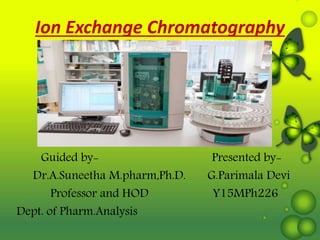
Ion exchange chromatography (1) (4)
- 1. Ion Exchange Chromatography Guided by- Presented by- Dr.A.Suneetha M.pharm,Ph.D. G.Parimala Devi Professor and HOD Y15MPh226 Dept. of Pharm.Analysis
- 2. DEFINITION Ion exchange chromatography may be defined as a reversible reaction in which free mobile ions of a solids called ion exchange are exchanged for different ions of similar charge present in solution EX:- insoluble organic polymer in to which charged group is introduced.
- 3. Ion exchange chromatography -- is a separation based on charge Used for almost any kind of charged molecules --- large proteins, small nucleotides and amino acids Ion-exchange chromatography preserves analyte molecules on the column based on ionic interactions Mobile phase – buffer, pH and salt concentration--- opposite charged solute ions attracted to the stationary phage by electrostatic force Stationary phase– resin is used to covalently attach anions or cations onto it
- 4. Common properties of all ion exchangers They are almost insoluble in water and inorganic solvents such as benzene, carbon tetrachloride, ether etc., They are complex in nature, i.e., infact they are polymeric. They have active or counter ions.
- 6. Principle The principle involved in the chromatography is the attraction between oppositely charged particles. Many biological materials such as amino acids and proteins, have ionisable groups and they carry a net positive or negative charge can be utilized in separating mixtures of such compounds. The net charge of such compounds is dependent on their pKa and pH of the solution.
- 8. Cation exchange chromatography retains positively charged cations because the stationary phase displays a negatively charged functional group: Anion exchange chromatography retains anions using positively charged functional group: .
- 10. ION EXCHANGE MECHANISM:- Diffusion of the ion to the exchanger surface. Diffusion of the ion through the matrix surface of the exchanger to the exchange site. Exchange of the ions at the exchange site. Cation exchanger Anion exchanger
- 11. Diffusion of the exchanged ion through the exchanger to the surface. Selective desorption by the eluant and diffusion of the molecule in to the external solution. CATION EXCHANGERS A cation exchanger is a high molecular weight, cross linked polymer having sulphonic, carboxylic, phenolic etc., groups as an integral part of the resin and an equivalent amount of cations.
- 12. Thus, a cation exchanger is nothing but a polymeric anion to which active cations are attached . In these cation exchangers the hydrogen ions are mobile and exchangeable with other cations When cation exchanger is kept in a solution of salt, some of the H+ ions of the resin enter the solution and in equivalent amount of the cations of the salt get attached to resin.
- 13. The resin having sodium ions produced in the above reaction, can exchange these ions with other cations. Some commercially available cation exchangers:
- 14. ANION EXCHANGERS:- An anion exchanger is a polymer having amine or quaternary ammonium groups as integral parts of the resin and an equivalent amount of anions such as Cl-, OH- ions etc. These ions are mobile and exchangeable.
- 15. Commercially available anion exchangers:
- 16. Regeneration anion exchanges are generally supplied in the form of Salts ,amines, in particular ,are stable only in this form. Cation exchanges can be converted in to the H+ form by treatment with aqueous acid followed by washing the ammonium base having hydroxyl group from the strongly basic anion exchanger on treatment with sodium hydroxide while the weakly basic anionic exchanges are converted in to free amines
- 17. ION EXCHANGE COLUMN USED IN CHROMATOGRAPHIC SEPERATIONS:- The principle is based on different cations or anions which have different capacities to undergo exchange reaction. This should depend upon the charge and the size of hydrated ion in solution. Therefore ionic charge plays an important role in determination of exchange reaction. The decrease in the order of capacity is as follows: Thorium>Aluminium>Calcium>Sodium Similarly, the decrease in the capacity among anions is as follows Phosphate ion>sulfate ion> iodine
- 18. Similarly the decrease in the capacity of univalant cations is H⁺>Cs⁺>Rb⁺>K⁺>NH₄⁺>Na⁺>Li⁺ The decrease in the capacity of doubly charged cations is :- Ba²⁺>Pb²⁺>Sr²⁺>Ca²⁺>Ni²⁺>Cu²⁺>Co²⁺>Zn²⁺>Mg²⁺ Similarly for univalent anions is :- I⁻>NO₃⁻>Br⁻>CN⁻>Cl⁻>OH⁻>F⁻
- 19. SELECTION OF SUITABLE SYSTEMS:- SPECIFICATION OF ION EXCHANGER IONIC GROUPS SUITABLE CHROMATOGRAPHIC MEDIUM Strong acid -SO₃⁻ Acidic and alkaline Weak acid -COO⁻ Alkaline Strong base -N⁺R₃ Acidic and alkaline Weak base -NHR2 Acidic
- 20. ION EXCHANGE TECHNIQUES There are two methods: Batch method Column method BATCH METHOD:- It involves single step equilibrium processes Resin+ Solution are mixed in a vessel. Filter the solution. The extent to which the ions from the solution are exchanged for those on the resin depends on the selectivity coefficient.
- 21. The batch method is used for softening of water and production of deionized water. E.g. Exchange of calcium and magnesium ions which causes hardness. 2RSO ₃⁻ Na ⁺ + Ca⁺ (RSO ₃⁻)2 Ca²⁺+ 2 Na ⁺ When resin is exhausted, a 15% of NaCl is added to the resin for removal of calcium ions. From deionized water all cations and anions of electrolytes have been removed and these cations are replaced by the hydrogen ions. E.g. RSO ₃⁻ H⁺ + M⁺ RSO ₃⁻M⁺+ H ⁺
- 23. COLUMN METHOD:- It involves in separation of components of a mixture by selecting different coefficient of resin. The difference in selectivity coefficient leads to different migration rates on ion exchange column. This involves frontal analysis, elution analysis, displacement development.
- 26. APPLICATIONS 1. Separation of similar ion from one another. 2. Removal of interfering radicals. 3. Softening of hard water. 4. Complete demineralization of water. 5. Separation of lanthanides. 6. Separation of actinides. 7. Separation of amino acids. 8. Separation of sugars.
- 27. REFERENCE https://www.harvardapparatus.com/download s/Ion%20Exchange%20Chroma%20SpinColu mn%20Guide.pdf. Instrumental analysis by Gurdeep R. Chatwal Instrumental analysis by Skoog.
- 28. Thank u all